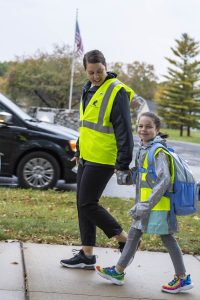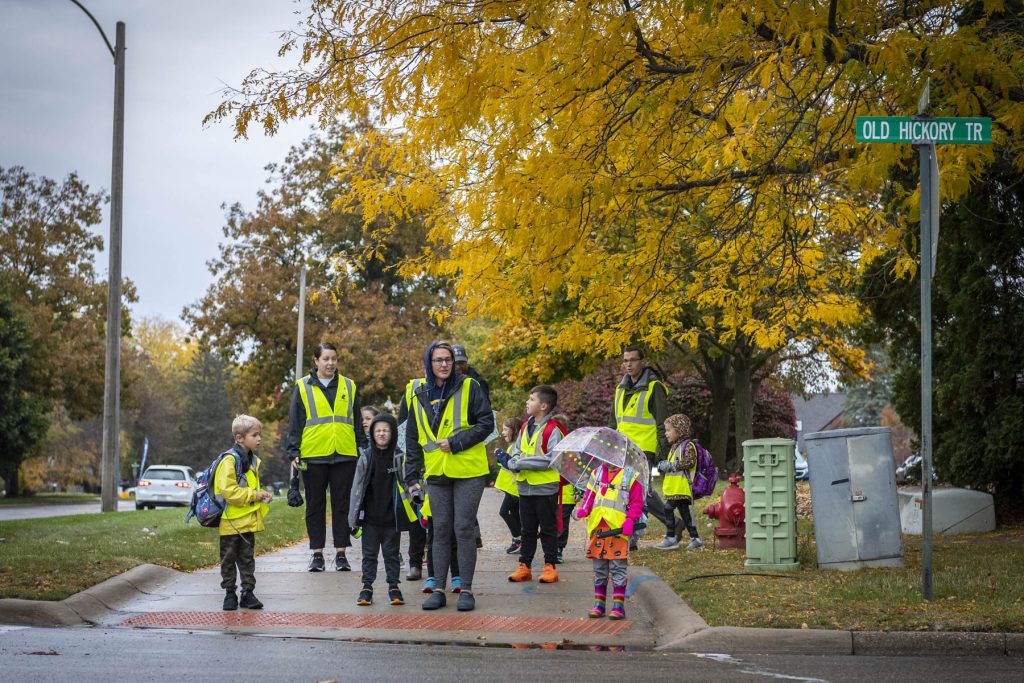
The City of DeWitt is home to nearly 5,000 residents. Settled in 1833 as a farming community, today it is a blend of charming rural and suburban neighborhoods with newly built quaint downtown district. It is centrally located in mid-Michigan about ten miles north of the State Capitol in Lansing and is one of the fastest growing communities in the region. Home to four elementary schools, one middle school, and one high school that serves nearly 3,200 students. The DeWitt community takes pride in being a safe and walkable community.
With funding from their Safe Routes to School (SRTS) Major Grant, DeWitt Public Schools, Clinton County Road Department, and the City of DeWitt embarked on infrastructure and noninfrastructure improvements to the areas in and around the schools. As is typical with a large scale SRTS project, there are typically two layers to major grant projects divided up as infrastructure and noninfrastructure improvements. Infrastructure improvements address the physical changes to the built environment; sidewalks, bicycle lanes, traffic diversion improvements, traffic calming, lighting, remote drop-off sites, and more. Noninfrastructure improvements addresses education and encouragement for things like student pedestrian safety education, bicycle rodeos, bike racks, parent and community education, funding for a part time SRTS coordinator, volunteer programs and training, increased law enforcement during the school commute, walking school buses, snow removal, and a variety of activities that encourage parents to allow their students to walk, bike, and roll to school safely.
The DeWitt SRTS infrastructure project was designed to create connectivity between four schools, nearby neighborhoods, a remote drop site, and included the installation of sidewalks along school properties and programming to inspire and support students on their school commute.
“I was lucky enough to have gone through the [Safe Routes to School] program in Manchester Community Schools where I became pretty familiar with the logistics, planning, and implementation involved with that grant, we did a pretty big overhaul of sidewalks and routes,” said DeWitt Public School Superintendent Shanna Spickard.
From that experience, Spickard understood the importance of creating stakeholder partnerships.
“Collaborating with stakeholders is really important,” said Spickard. “We worked closely with the city and township…so many people really worked together to make it happen.”
By creating and expanding sidewalks and walkways, they were able to connect two neighborhoods to school properties, and add additional infrastructure improvements like crosswalk striping, signal upgrades, and ADA facilities to provided much needed connectivity across the community.
DeWitt’s noninfrastructure programming goals were safety education, shifting student and parent perceptions about walking, biking, and rolling to school, and finding ways to inspire students to be active on their school commute.
A highlight of their programming is the walking school bus known as the “Magic School Bus.” It provides students the ability to walk to and from school safely with adult supervision and a way for parents to skip the drop off lines at the school, which can be logistically challenging for parents with children attending more than one school.
Drawing on her experience in Manchester, Spickard also understood student and parent participation required a flexible programming approach. She also understand the importance of creating a paid position for someone to manage the program.
DeWitt budgeted a portion of their SRTS grant noninfrastructure funding to hire a part time walking school bus coordinator as previous volunteer coordinators had multiple responsibilities that could be alleviated by creating a paid position for a person to provide students with safety education, coordinates the volunteer program, and manages community partnerships. Danielle Guty was hired to manage all aspects of the Magic School Bus program.
“The police department and road commission have helped us keep the kids safe by adding new signage, painting crosswalks, slow down school signs, and other things that equip and educate the community to provide a safe space for the students on their commute,” said Guty. “We also use ICHAT for Michigan criminal history and background checks to vet our volunteers.
This means parents can rest easy and allow their children to participate in the Walking School Bus knowing there are safety measures and qualified adult supervision in place. The program also provides equipment like headlamps, flashlights, umbrellas, and ponchos to help students walking in the rain, snow, and darker days of winter to ensure everyone is visible, safe, and comfortable on the school commute.
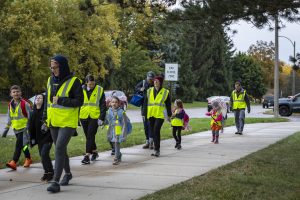
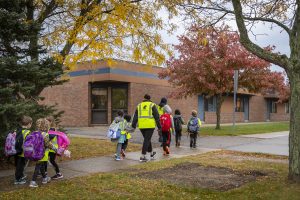
As volunteer coordinator, Guty manages schedules, recruits, and trains volunteers.
Volunteers are trained to identify how, when, and with whom students are leaving school and where students should be based on their list of student participants. Though, the program still looking for ways to improve managing volunteer and student schedules in real time.
“One of the biggest challenges was finding a way to improve the tracking of volunteers and which students are supposed to be walking each day, especially for pickups, because it is very chaotic at pickup with say 15-20 kindergarteners and first graders,” explains Guty. “So, putting a process in place and being able to update it in real time is important.”
They found using a blend of Google Docs and SignUpGenius made it possible to collect volunteer, participant, and parent information.
With input from school principals, secretaries, and other admin staff, Guty explored more of the administrative and student safety side of the program, what was working, what was challenging, and found ways to set up a notification process between the school, parents, and volunteers.
“Now, when the school gets notified that so and so was not walking today, they update us and vice versa,” said Guty.
As a proactive measure and by recommendation from the school staff, they bought a subscription to use the SignUpGenius app. The app makes is possible to send weekly automated reminders to parents to post any schedule changes for the upcoming week. Being able to have updates made in in real time means the school and volunteers have accurate student lists and parents have an app where they can post last-minute changes to their child’s school schedule.
“We want to prevent communication mishaps,” says Guty. “So, this process has worked really well. For example, if Suzy is in the walking school bus line, but she’s not on our list, we have a process for confirming where Suzy is supposed to be, and everyone has the most up to date information…like five minutes before school gets out.”
The app reduces the stress on everyone involved in the communications loop. And, from a safety standpoint, the efficiency of the app makes it possible for volunteers to contact parents immediately if a student is late or doesn’t show.
“They volunteers know when parents are dropping kids off or picking them up, what vehicle they are in, and [by having the app], we’ve been able to get more secure measures in place,” says Spickard.
“We have some really dedicated volunteers who are there every single day,” expressed Spickard. “We are always thinking about the volunteers, especially around retention and burnout. So, we ask for their opinions, suggestions, and feedback to improve the program efficiency,” explained Spickard.
For example, they use social media to recruit more volunteers and to reduce burnout they pause the program from time to time to give everyone a little break during the holidays or winter months. They also provide tokens of appreciation to the volunteers.
Before Guty came into the role, the DeWitt business community was supporting volunteers with gift cards, student gifts like sidewalk chalk, discounts, and more to show their appreciation. Today, the business community is still showing their volunteer support. Guty says it is important to recognize the volunteers and she carries on the tradition set in place before she arrived. She has added to the tradition by writing handwritten thank you notes and recruiting more businesses to recognize the volunteers.
“I’ve also learned a lot [about the program] because I have two kids that do the program. Being a consistent volunteer helps me gain knowledge and understand the time and effort it takes to volunteer…as well as the processes we need to fix,” said Guty. “We are really grateful for the outpouring of support from our business community.”
The program has sought feedback from the students as well, which has been positive.
“They say it’s fun, and for the students whose parents volunteer, they say they really enjoy walking with their parents. It’s become a family event,” said Spickard.
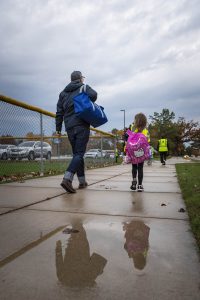
“The students say they also really enjoy the extra time with friends and the feelings of independence that walking to school provides,” adds Guty.
The program is now entering its third year and impact of the DeWitt SRTS program has had a positive impact on the students, school, and larger community. While it has been a success to date, they have a goal to get more students to use active transportation methods on their school commute.
“One of the things that I talk to parents about is they can [stay outside the school] in line idling for 45 minutes, or they can drop the kids off faster, get to work earlier, and they don’t have to wait in the line. So, I think getting that messaging out may help increase participation,” said Spickard
With infrastructure upgrades, logistics, and support programming in place, DeWitt is creating safe routes to school for their students.
“Improved safety in our community lends toward more parents letting their students walk and ride to school,” explained Guty. “The students really enjoy that extra time with family and friends and the feelings of independence that walking to school provides.”
The program has done more than reduce transportation logistics and the burdens that go with for parents, it has created community.
Project Impact
The Clinton County Road Commission expanded and improved walking, biking, and rolling infrastructure to provide active transportation opportunities for students, residents, and the larger community for generations to come.
In summary, DeWitt’s SRTS noninfrastructure programming included a walking school bus program, encouragement items, bike rodeos, and safety education provided by the local police department. A volunteer program was also created with a subscription to SignUpGenius to enable volunteer scheduling and easy two-way communications between the school and volunteers.
- MDOT SRTS Infrastructure Investment: $949,004
- MDOT SRTS Non-Infrastructure Investment: $31,843
- Clinton County Match Contribution: $65,151
This project was made possible through the continuing collaborative efforts of DeWitt Public Schools, Clinton County Road Commission, the City of DeWitt, DeWitt Township, Watertown Charter Township, Michigan Fitness Foundation, Michigan Department of Transportation, and the Federal Highway Administration.

